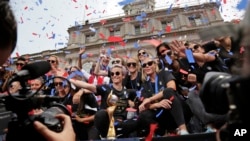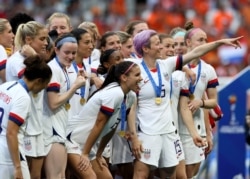From its earliest days, women’s soccer didn’t get much respect from sport organizers.
Take the first World Cup in 1991, which wasn’t even called the “Women's World Cup.” Sponsored by Mars Inc., the candy empire, the event was branded the “1st FIFA World Championship for Women's Football for the M&Ms Cup.”
“They weren't paid. They got $10 per diem a day. They were wearing hand-me-down uniforms. They weren't staying in the best hotel rooms,” says Eileen Narcotta-Welp, an assistant professor of sport management at the University of Wisconsin-La Crosse. “They were literally eating Snickers and Pepsi to kind of fuel them through the 1991 game.”
The U.S. women won that tournament.
Today, female soccer players get paid, but not enough, according to a lawsuit the U.S. women's national soccer team (USWNT) filed against U.S. Soccer, their employer, alleging, “institutionalized gender discrimination.”
The United States Soccer Federation (USSF), also commonly referred to as U.S. Soccer, is the official governing body of the sport of soccer in the United States.
The lawsuit alleges that female players each earn a maximum of $99,000 for a season, while the men make an average of $263,320.
In the 28 years since that first World Cup win, the U.S. women’s team has been wildly successful, taking home four Women's World Cups in all, including the 2019 title captured on Sunday in a 2-0 victory over The Netherlands, four Olympic gold medals, and eight CONCACAF Gold Cups.
The U.S. men haven’t fared as well, failing even to qualify for the most recent men’s World Cup in 2018. In fact, throughout the tournament’s 89-year history, the U.S. men have never earned a World Cup.
And yet, despite a lackluster record, the U.S. men are paid significantly more than the women.
For example, there was a $730,000 gender pay gap in 2019 U.S. World Cup bonuses, according to The Guardian.
The world champion women’s team members — who were honored Wednesday in a ticker-tape parade in New York City — will earn a maximum of $260,869 each after winning the World Cup and going on a victory tour. But if the U.S. men had accomplished the same feat, each of them would have earned more than $1.1 million.
Each member of the U.S. women’s national team earned $90,000 in bonuses for reaching the quarterfinals. But if they’d been eligible for the same bonuses as the U.S. men, they’d have raked in $550,000.
Total prize money for all teams involved in the 2018 men’s World Cup added up to $400 million, while the women’s prize money total for 2019 is $30 million.
In a court filing in response to the lawsuit, U.S. Soccer argued that the difference in pay between the men and women players is “based on differences in aggregate revenue generated by the different teams and/or any other factor other than sex.”
The compensation issue was on the minds of fans in the crowd at Wednesday’s parade salute to the women’s championship team.
“They're doing the same hustle,” says Jaida Brown, a spectator. “They're out there in the media and they're inspiring people, and that's what I feel like it's all about, so they definitely should get equal pay as a man.”
“The whole team has been very powerful, and it’s just really empowered me,” says Yvonne Duck, another who turned out for the parade. “As a woman, I really feel strongly that they should be paid equally. It's so unfair.”
David Gibbs attended the parade with his two daughters, including a 9-year-old who plays soccer. He coaches her team, in addition to coaching in the recreational soccer league he plays in.
“The whole issue of them getting equal pay is something that they do in the workplace,” Gibbs says. “Why not in the sports arena, as well?”
Since winning the World Cup in 2015, the U.S. women’s soccer games have earned more revenue than the men, according to The Wall Street Journal, which reported that the women generated $50.8 million in revenue between 2016 and 2018, while the men brought in $49.9 million.
The women’s earning power also extends to merchandise. Nike says the U.S. women’s soccer jersey is the top-selling soccer jersey, men’s or women’s, ever to be sold on Nike.com in one season.
Not only are the women paid less, but U.S. Soccer has used their success to try to jump-start interest in men’s soccer. In 1999, in the run-up to the Women’s World Cup, U.S. Soccer scheduled men’s games right before the women’s matches in hopes of drawing more attention to the men.
“They did this kind of combination package to get people to watch the men's game because they knew that people were going to come and watch the women,” says Narcotta-Welp. “I think that the USSF has consistently used the women as a way to propel the men's team into visibility — financial visibility, spectatorship visibility,” she says.
But no matter how well the U.S. women perform for the masculine-oriented FIFA, soccer’s world governing body, it’s all still about the men’s game. According to Narcotta-Welp, FIFA won't take U.S. Soccer seriously until it fields a formidable men’s team that can compete on the international stage.
“You don't see FIFA pressuring other federations to invest more in the women's soccer game," she says. "They probably look at the United States and say, ‘Well, you're riding high. You're tough. You don't need to do as much because your women's game is already there.’”
After the U.S. women secured their second consecutive World Cup victory in Lyon, France, last Sunday, fans in the grandstands chanted, "Equal pay, equal pay."
The U.S. women’s team filed their lawsuit against U.S. Soccer in March, but agreed to focus on the World Cup first and then begin mediation on the issue of equal pay after the conclusion of the tournament.
For Narcotta-Welp, the general solution is simple, especially considering what the U.S. women’s soccer team has done for the sport.
“The women's team in all of its iterations, literally has brought the game of soccer not only into conversations within American households, but this team is also the first to successfully market and sell soccer to a naive and seemingly indifferent American sports market,” she says. “At this moment, they are cultural icons and should be paid as such.”
VOA correspondent Tina Trinh contributed to this report.










